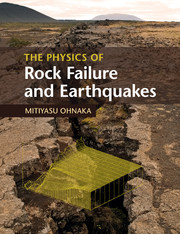Book contents
- Frontmatter
- Contents
- Preface
- 1 Introduction
- 2 Fundamentals of rock failure physics
- 3 Laboratory-derived constitutive relations for shear failure
- 4 Constitutive laws for earthquake ruptures
- 5 Earthquake generation processes
- 6 Physical scale-dependence
- 7 Large earthquake generation cycles and accompanying seismic activity
- List of illustration credits
- References
- Index
Preface
Published online by Cambridge University Press: 05 April 2013
- Frontmatter
- Contents
- Preface
- 1 Introduction
- 2 Fundamentals of rock failure physics
- 3 Laboratory-derived constitutive relations for shear failure
- 4 Constitutive laws for earthquake ruptures
- 5 Earthquake generation processes
- 6 Physical scale-dependence
- 7 Large earthquake generation cycles and accompanying seismic activity
- List of illustration credits
- References
- Index
Summary
Over the past four decades, great progress has been made in scientifically understanding earthquake source processes; in particular, advances in the field of earthquake physics have contributed substantially to a profound understanding of earthquake generation processes in terms of the underlying physics. Yet, a fundamental problem has remained unresolved in this field. The constitutive law governing the behavior of earthquake ruptures provides the basis of earthquake physics, and the governing law plays a fundamental role in accounting quantitatively for the entire process of a scale-dependent earthquake rupture, from its nucleation to its dynamic propagation to its arrest, in a unified and consistent manner. Therefore, it is critically important to strictly formulate the constitutive law for earthquake ruptures, based on positive facts, from a comprehensive viewpoint.
Over the past two decades, however, there has been controversy regarding what the constitutive law for earthquake ruptures ought to be, and how it should be formulated. For the physics of earthquakes to be a quantitative science in the true sense, it is essential to resolve this controversy. Regrettably, the resolution of seismological data observed in the field is not high enough to end the controversy. In order to resolve this controversy, therefore, it is critically important to formulate the constitutive law based on positive facts elucidated by high-resolution laboratory experiments properly devised for the purpose intended, by correctly recognizing the real situation of seismogenic fault properties. Without a rational formulation of the law governing real earthquake ruptures, the physics of earthquakes cannot be a quantitative science in the true sense. Hence, there is an urgent need to rationally formulate the constitutive law for earthquake ruptures, based on positive facts, from a comprehensive viewpoint. Resolution of this controversy is a necessary step towards a more complete, unified theory of earthquake physics.
- Type
- Chapter
- Information
- The Physics of Rock Failure and Earthquakes , pp. viii - xPublisher: Cambridge University PressPrint publication year: 2013



